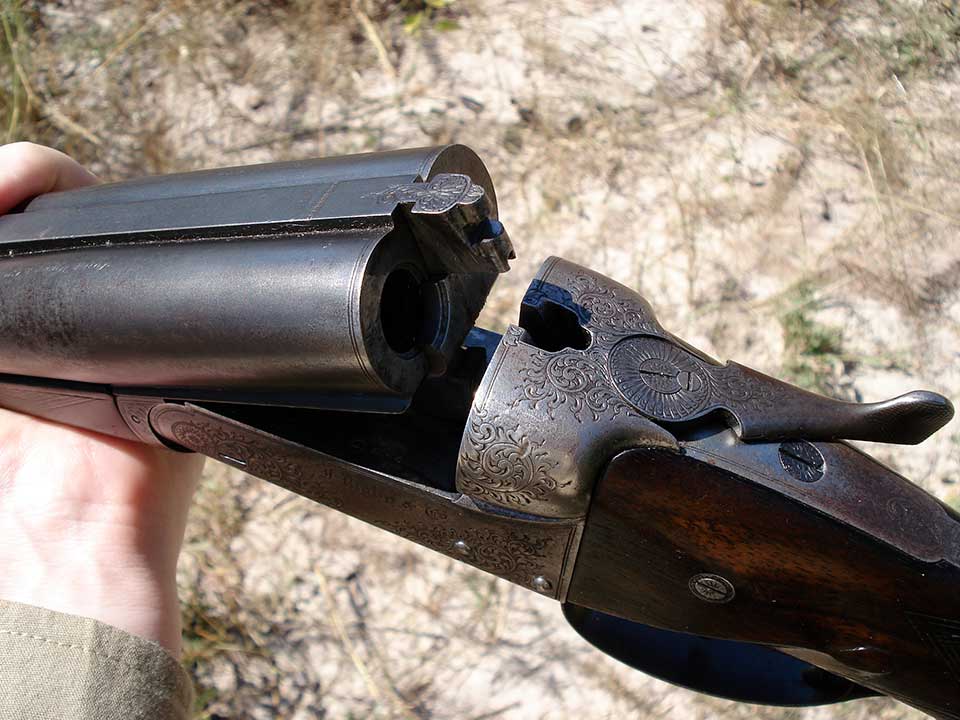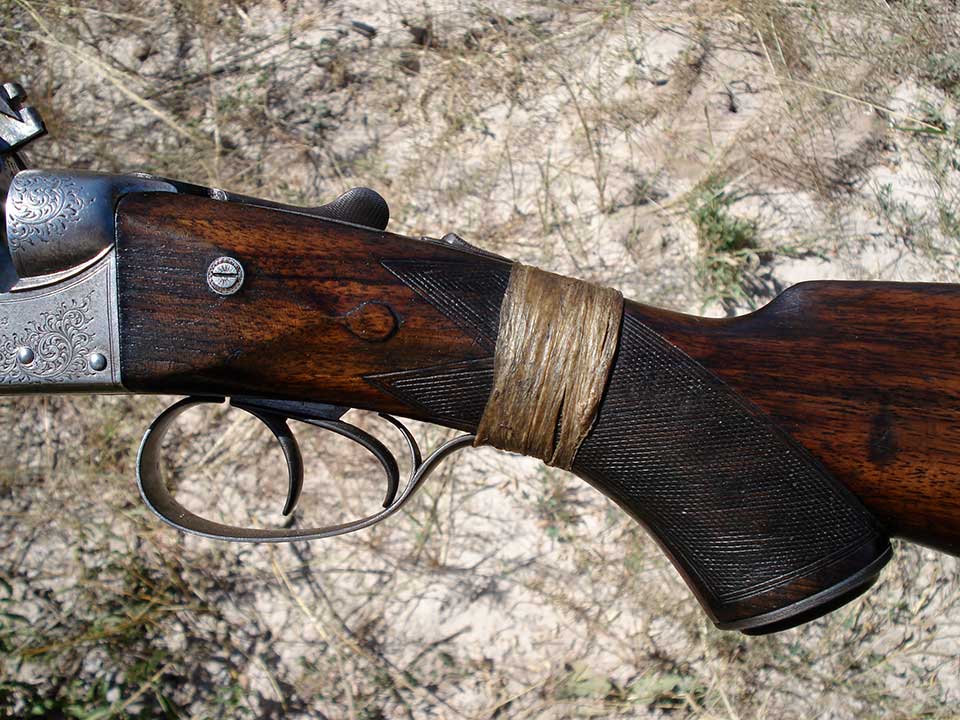If the old adage ‘the proof of the pudding is in the eating’ were applied to rifles, some would taste better than others.
Africa has been trying to eat sporting rifles for two centuries. Some have proven quite indigestible. None more so than the early 19th century boxlocks made in Birmingham and sold by all the major, and some of the minor, manufacturers in the years between the turn of the century and the start of the second World War.
While many younger professional hunters today can be seen shouldering cheap continental bolt-actions, the older chaps are more often in possession of a family heirloom, passed down from father to son or perhaps from an old-timer they knew as a young man. These are usually boxlocks. Sometimes ejectors, usually not. Ejectors are an added complication. Invariably double triggers. Single triggers are a liability.
Well, I say single triggers are a liability, James Sutherland wrote that his Westley Richards .577 with single trigger never let him down despite many years of hard elephant hunting. So, perhaps I’m being unkind. However, in my experience it is ejectors and single triggers that go wrong on English guns with far higher frequency than any other mechanism. Perhaps I’m overcautious but were I ordering a rifle to take to Africa for the next fifty years of dangerous game hunting, I would opt for two triggers.
A good Southgate ejector is a reliable thing nowadays and has been since before the First World War, so I’d have them fitted. Besides, if ejectors start to fail, they can be removed and ejector failure is not going to get you killed like single trigger failure is. It seems most people back then thought like I do now, as the double trigger boxlock is the norm.
As for calibre, the most common will be various permutations of .450. After 1907 the .470 starts to take over the .450 territory and .500 maintains a presence right up to the modern era. Other calibres do make an appearance, the .475 and the .577 amongst them. Despite the undoubted qualities of the various cartridges available, the .470 is probably the classic between the wars ‘stopper’ for the professional hunter.
A quick Google search for .470 boxlocks will quickly bring up rifles by Cogswell & Harrison, Westley Richards, John Rigby, Joseph Lang and others, but the majority of these rifles were made in the Birmingham trade by specialist suppliers, like Daniel Leonard or big factories, like W&C Scott, who after 1897, amalgamated with P. Webley to become Webley & Scott.
The ‘long-table Webley’ action is a real classic and was used as the platform for big game rifles of all the ‘stopping calibres’ in a wide range of qualities and supplied to most London and provincial firms. Be it a London firm offering a Purdey ‘C Quality’ or a Henry Atkin best boxlock or an overseas agent selling English guns to colonials, like R.B Rodda or a Lyon & Lyon, the need being met was the same and the source material was ideal.
While the aristocrat or gentleman hunter may have carried a Purdey or Holland & Holland sidelock, the classic boxlock double rifle for colonial service had a robust Anson & Deeley action, with a long bar, perhaps with side clips on the fences and a third bite in addition to the Purdey double bolt. Engraving will vary from minimal border and scroll around the pins, to 50% or more, increasing in quality and intricacy as the model grew in price.
Wood work will usually be an English pistol grip with a Silver’s pad being a common addition to the butt. Many of these will now be severely perished. Long guard straps and top straps are not uncommon, providing added security in the event of the stock getting dropped or knocked. Many chose a non-automatic safety. You don’t want to quickly load and fire at a charging animal only to find you forgot to push the safety off at the crucial moment.
Every professional hunter has some hairy stories to tell about his rifle or the rifle of a colleague. I was hunting in Tanzania last year with Danny McCallum, one of the last old-time hunters, now in his seventies, born in Kenya and raised as an African ‘white hunter’. He has lived his life in hunting camps since he was in his twenties. While in camp he brought out a grubby and battered old gun case and inside was a sad sight indeed.
It was a boxlock double rifle; a typical ‘P.H rifle’ and it had seen better days. Danny had seen it in the hands of an older colleague for most of his life. Upon the owner’s death, it had been gifted to Danny. Hunting life being what it is, it took some years before the last outfitter for whom the old owner had worked, managed to get in touch with Danny. They met up and the outfitter mentioned he had the old rifle in the shed. The shed had a leak. Water had been dripping onto the case and through the canvas onto the rifle, which had rusted terribly. The wood had also deteriorated.
Danny offered it to his young understudy, Tom, if he could be bothered to restore it. We took a good look at it. Restoration to the usual standard was uneconomic. However, could we bring the rifle back to useful life, cosmetics aside? Still doubtful. Perhaps Africa had eaten this one.
Danny himself still carries his old trusty .475 No.2 boxlock. Typically bereft of blacking, the tubes worn to a steely silver from decades on his shoulder, chequer rubbed by sweaty, dusty hands until a mixture of wear and filling had left it black and smooth. No longer tight on the face, Danny rarely fires the old girl these days but when he does, she still does her work. The .475 No.2 is a fierce cartridge but the thump at the other end is reassuring.
For the occasional hunter heading for Africa who is looking for a dependable but un-flashy English double rifle, there are still sensible options available and these plain professional hunter model boxlocks are affordable, dependable and seriously capable. No need to feel under-gunned in the hunting camp. Far better to un-sleeve a real, tried and tested English boxlock, even one with a bit of wear and a few repairs, than a brand new foreign cheapie, in my opinion.
An imperfect but sound ‘shooter’, rather than a pristine ‘collector’ type purchase is what is required for this kind of venture. No matter if the action is a bit worn or there is a bit of external pitting. Dents in the wood, worn chequer, replaced or repaired parts here and there don’t matter. Concentrate on good bores, un altered barrels with sound ribs, lumps and loops, good jointing and proven to shoot straight at fifty yards. For this, expect to pay around £5,000. It may take some time to find but they are out there.
Three days into your safari, big boomer over your shoulder as you, your tracker and your PH push through the low branches of the mopani on the track of a buffalo, confidence will be instinctive, the rifle will feel like it belongs there, where it has always been, ready to speak with authority when the moment arrives.
Published by Vintage Guns Ltd on




